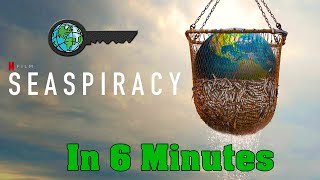Genre: Investigative Documentary / Environmental Exposé
Language: English
Director & Narrator: Ali Tabrizi
Released: 2021
Runtime: Approx. 89 minutes
1. What Is Seaspiracy Really About?
At the surface level, Seaspiracy is a documentary about ocean conservation and the devastating impact of commercial fishing. But underneath that, it becomes something far more radical and confrontational:
It is a visceral, globe-trotting investigation that pulls back the curtain on what the filmmaker argues is one of the most industrially protected, ecologically catastrophic, and morally unsettling practices in human history—industrial fishing.
But Seaspiracy is not content with being a nature documentary. It morphs into a kind of eco-thriller, part journalism, part confessional, part polemic. It dares to name names, criticize even non-profit environmental organizations, and call into question some of the most accepted forms of “sustainable” living.
2. The Narrative Arc: From Passion to Disillusionment
The film follows Ali Tabrizi, a young British filmmaker and ocean lover, who starts off wanting to protect marine life—especially whales, dolphins, and plastic pollution. He begins with idealism, filming beach cleanups and showcasing the visible consequences of human negligence (like plastic straws, nets, and microplastics).
But his journey quickly shifts. As he digs deeper, he discovers that the biggest threat to marine life isn’t plastic pollution or oil spills—it’s industrial fishing itself.
What follows is a global odyssey:
- From Japan’s infamous dolphin hunts and whaling
- To West Africa’s depleted fisheries and local poverty
- To Thai fishing fleets linked to forced labor and slavery
- To the Faroe Islands’ centuries-old whaling tradition
- And into boardrooms of environmental organizations unwilling to speak about fishing
Tabrizi becomes disillusioned with institutions and NGOs he once trusted. His personal journey—from optimism to anger, grief, and confrontation—mirrors the arc of the film.
3. Major Themes & Messages
A. The Collapse of Marine Ecosystems
The film presents one horrifying truth:
“If we don’t stop industrial fishing, we’ll have empty oceans by 2048.”
It argues that overfishing, not climate change alone, is the leading cause of marine biodiversity collapse. Every minute, massive trawlers scrape the ocean floor, killing thousands of non-target species (known as bycatch)—sharks, dolphins, turtles, and more.
Bottom trawling is depicted as a form of underwater genocide—wiping out entire ecosystems with military-scale efficiency.
B. The Myth of “Sustainable Seafood”
One of the most aggressive points the film makes is this:
“There is no such thing as sustainable fishing at an industrial scale.”
Logos like “Dolphin Safe” and “Sustainable Seafood” are scrutinized and shown as largely unverifiable, profit-driven greenwashing tools. Tabrizi interviews former insiders who admit that these labels are based on trust, not ironclad auditing. There’s no way to ensure that massive fishing vessels truly avoid bycatch or follow best practices—especially in international waters.
This part of the film shatters the feel-good illusions many people rely on to reconcile their seafood consumption.
C. Human Cost: Slavery & Exploitation
In a chilling twist, the film shifts to human rights abuses within the fishing industry. Particularly in Southeast Asia, Tabrizi reveals how many fishers aboard long-distance vessels are slaves—trapped, beaten, or even killed.
This is where the documentary becomes truly unsettling. It’s not just about ocean life—it’s about modern slavery hidden inside your sushi.
D. Environmental Hypocrisy
One of the most controversial (and brave) aspects of Seaspiracy is its direct criticism of established environmental NGOs. Groups that publicly campaign against plastic straws or whale hunting are accused of ignoring the deeper, more inconvenient truth—that industrial fishing is the real killer, and they don’t want to lose donor support or political connections by saying it.
This paints a picture of an environmental movement that has, in part, sold out—prioritizing optics and manageable campaigns over systemic change.
E. The Vegan Solution
The film culminates in one of its most provocative arguments:
“If you really care about the ocean, stop eating fish.”
Rather than advocating for better regulation, more marine reserves, or eco-conscious consumption, Seaspiracy goes all in on a plant-based diet as the only ethical and sustainable choice.
This stance is radical because it refuses compromise. The film insists that no version of large-scale seafood consumption is morally or ecologically defensible.
4. Emotional and Cinematic Language
Tone & Atmosphere
The tone of Seaspiracy is urgent, at times angry, and emotionally raw. It’s not objective journalism—it’s a crusade. The film leans into shock, horror, and outrage to jolt viewers awake.
Some segments feel almost like a thriller—hidden cameras, risky interviews, menacing industry figures. Tabrizi isn’t just presenting facts; he’s placing himself in the narrative, risking confrontation, and sometimes breaking down on camera.
Visual Storytelling
- The film’s imagery is haunting: lifeless dolphin bodies, blood-soaked waters, fish dumped by the ton, starving communities near empty coastlines.
- Contrasted with that are serene shots of oceanic beauty, whales swimming peacefully, coral reefs teeming with color.
- This contrast reinforces the theme: we are killing what we claim to love.
5. Criticism, Bias & Complexity
While Seaspiracy is powerful, it has also drawn criticism:
- It oversimplifies complex issues (not all fishing is equally destructive).
- It generalizes small-scale fishermen with industrial players.
- It makes unverified claims and statistical leaps, sometimes choosing drama over data.
- It doesn’t always acknowledge the role of indigenous, sustainable, community fishing in food security.
But even these criticisms prove something essential:
Seaspiracy is not neutral. It is a weapon. It is not designed to pacify, but to provoke action—through discomfort, confrontation, and moral clarity.
6. Final Message: A Moral Reckoning
At its heart, Seaspiracy asks you to look at your plate and consider the chain of violence that brought it there.
It wants to dismantle the idea that you can be an ocean lover and still consume its inhabitants.
It asserts:
- That the ocean is not a resource but a living, sacred ecosystem
- That the idea of dominion over nature is arrogant and suicidal
- That protecting the ocean requires no longer extracting from it
7. Conclusion: More Than a Documentary
Seaspiracy is not just a film, it’s a call to ethical transformation.
It’s messy, bold, at times one-sided, but undeniably emotionally explosive and culturally consequential.
Where most environmental films plead, Seaspiracy demands.
Where others compromise, it condemns.
Where some educate, it agitates—forcing you to confront uncomfortable truths about what you support, consume, and ignore.

